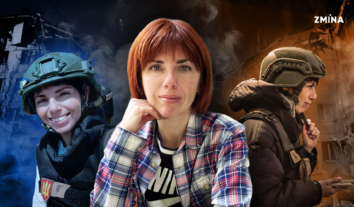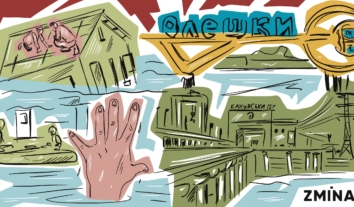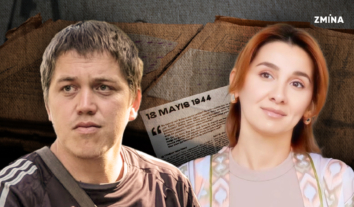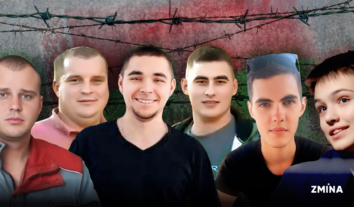Off the radars. What do captives of Donbas go through?
#FeelYourRights
Today, on the International Day for the Abolition of Slavery, Ukraine can speak not only about the risks of human trafficking, sexual exploitation, torture and forced labor but also a phenomenon which has been a sort of parallel reality to us – the captives.
Meanwhile the uncertainty is driving the relatives and friends crazy, the servicemen, the civilians, and those, who can’t be touched even by the laws of war, captured in Donbas, become the object of torture and often the source of information about the situation “on the other side.”
Journalists in captivity
Saying you are non-combatant is no guarantee of safety. The media workers, who are being captured in the territory of the armed conflict, probably, more often than the servicemen actually, are suspected of espionage. Perhaps, the fact they always have some recording means is another reason for such suspicion.
Roman Cheremsky, the Kharkiv public activist, the founder and journalist of the Ukrainian Space magazine was held captive by the “LPR” militants during August 17 – December 26, 2014. He was captured at a checkpoint with Cherkasy human rights activist Valeriy Makeyev and the crew of 112 TV channel. The TV journalists were released in three weeks, the human rights activist was freed on November 23, while Roman stayed there the longest.
After he had been released, he told colleagues that, by and large, nobody should expect some special attitude. If a militant maims or shoots dead a captive journalist, he won’t be punished for that.
“Anyone, even an ordinary guard can kill you, but even a commander cannot release you,” Cheremsky said.
He also notes that people, whom nobody tries to liberate, may remain there for the indefinite period of time. The militants have enough resources to keep the captives. The captives are not a burden, which the militants seek to get rid of. Roman says that there is enough food to feed the prisoners well, and, if necessary, they are used as the additional labor to clean the barracks or peal vegetables in the kitchen.
Luhansk journalist Maria Varfolomeyeva was captured on January 9 this year and is still held captive by the “DPR” militants. The militants did not like that she took photos in Luhansk for one of the Kharkiv media outlets, as she said. Subsequently, the militants charged her with “adjustment of artillery fire.” According to Oleksiy Matsuki, the editor-in-chief of the “News of Donbas”, the journalist was already sentenced to 15 years in prison by the decision of the so-called “Security Service of the Luhansk People’s Republic.”
Ukrainian and Polish journalists describe holding Varfolomeyeva captive on trumped-up charges as another violation of human rights and call for her release. The Patriot group and the Security Service of Ukraine claim they are dealing with the issue of liberation of the journalist, but there is still no result.
What do captives know?
Interrogation is inevitable during captivity, and the parties find out a lot about the armed conflict, the motivation of participants, the methods of warfare. For example, it turns out that one of the sources of supply of new fighters for the self-proclaimed republics in Donbas is Russians who face imprisonment at home.
January 25, near the village of Sanzharivka, Donetsk region, the Ukrainian military detained a tank driver, a Russian citizen, resident of the Krasnodar Territory, who had three criminal records. He was arrested for stealing a car in Rostov-on-Don, Russia, and a local police chief offered him going to Donbas to protect the “Russian world” having promised to dismiss all the charges against him and close the criminal case. The man agreed.
The captive fought on the side of the “LPR” in Luhansk region and participated in the fighting against the Ukrainians near Debaltseve. He also said that there were about 70% of Russian citizens in his unit, who abolished their prison sentences in such a way.
Who were captured near Shchastia?
May 16, the Ukrainian servicemen of the 92nd separate mechanized brigade during the combat operations near the town of Shchastia, Luhansk region, detained Russians Alexander Alexandrov and Yevgeny Yerofeyev, the agents of the sabotage and reconnaissance group.
The OSCE Special Monitoring Mission representatives talked in private with the Russian intelligence officers at the Kyiv hospital, where they were sent for treatment. After the meeting, the mission representatives confirmed that the captives were the officers of the Main Intelligence Directorate of the Russian Federation.
Advisor to Ukraine’s Interior Minister Anton Herashchenko then suggested exchanging the Russians for Ukrainian pilot Nadiya Savchenko, held in Russia. But her lawyer, Mark Feygin, said that was unlikely.
Later, the Russian spies were arrested by the decision of the Shevchenkivsky District Court of Kyiv until July 19. In fact, the Russian Defense Ministry abandoned Alexandrov and Yerofeyev, saying they had come to Ukraine after the dismissal. In August, Ukrainian Ombudsperson Valeria Lutkovska visited the detainees in remand prison and noted that they did not complain about the conditions of detention.
However, in November, the lawyer of Yevgeny Yerofeyev demanded during the court hearing to exclude from case materials the video, showing Yerofeyev admitting he is a Russian serviceman. The lawyer believes it to be improper evidence as Yerofeyev said he had been tortured during the video recording. Who knows, maybe, it is the manipulation to “cancel” the previous unwanted disclosure. And it is also unclear what should be done with the statement made by the OSCE monitors after the meeting with the two detainees.
“Parade of prisoners” and international statements
The leaders of the breakaway republics and the illegal armed groups are sometimes prosecuted and notified of suspicion, but symbolically and in absentia. And the only possible response to the ongoing tyranny towards the prisoners is the statements of the international organizations and the documentation of these events for further meetings in The Hague.
In July 2014, the video appeared on the Internet showing leader of the militants of the self-proclaimed “DPR” Lieutenant Colonel Igor Bezler a.k.a. Bes interrogating Ukrainian prisoner Oleksiy Kudriavtsev. The witnesses, who were in the same captivity in Horlivka, said later that Bezler shot Kudriavtsev dead. November 10, he was notified of suspicion of homicide. But the investigation is complicated by the fact that the territory of the commission of the crime is still under the control of the terrorists.
The human rights defenders have also claimed that there are at least five witnesses of murder of the Donetsk Airport defender Ihor Branovytsky by one of the rebel leaders known as Motorola.
The fate of Colonel Ivan Bezyazykov remains unknown. He was captured by the pro-Russian separatists on August 16, 2014 near the village of Stepanivka, when he came out with a white flag to negotiate on temporary ceasefire. According to the eyewitnesses, he was severely beaten and tortured in captivity, and his execution was simulated several times. He was able to talk with his wife on the phone several times, but then the connection was lost. The human rights activists urge to sign the statement demanding to reveal the whereabouts of the Colonel and protect him from torture.
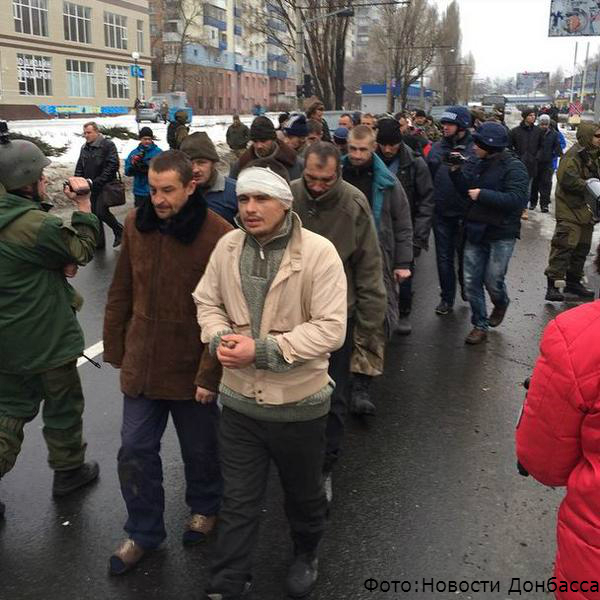
January 22, the militants held the “parade of prisoners” in Donetsk, bringing them to the place of morning fire at the transport interchange, killing 15 people. The “DPR” militants accused the Ukrainian military of shelling, and the Ukrainian servicemen claimed that the place of shelling was located 15 km away from the Ukrainian positions and accused the militants in turn.
During the “parade”, the local residents came to the prisoners shouting insults and beating them. Then, the prisoners were forced to kneel down and apologize. The Russian TV channels filmed and covered the event.
Human Rights Watch, Amnesty International, the OSCE and other international organizations have condemned the shelling and the treatment of prisoners, describing it as the violation of international law, and describing the nature of coverage of these events by the Russian media as the violation of journalistic standards.
The report of the international human rights organization Amnesty International says that both the militants and the Ukraine’s representatives tortured the captives and used them as the “currency” for the prisoner exchange. The organization’s experts drew such conclusion after they had interviewed 17 people, who had been held captive by militants, and 16 people, who had been held captive by the Ukrainian side.
The Security Service of Ukraine said in response that it held captive no prisoners and only detained the persons suspected of terrorist activities, attacks on state security, and actions aimed at the seizure of state power, and kept them in custody pursuant to the court’s ruling. The Security Service also invited the international experts together with the military prosecutor’s office to investigate all the cases referred to in the Amnesty International’s report.
How to survive in captivity
The psychologists and those who went through captivity say that the captives should not behave in a provocative manner to survive as it can irritate and provoke the abductors, who get pathological pleasure from torture.
It is better to behave naturally, communicate with militants in the language they understand, bearing in mind that these people are more guided by emotions than by reason. The self-sufficiency and confidence will be appreciated even in the criminal world, even if your views about life do not coincide.
It is necessary to try to communicate with the leaders, not the performers because they tend to be more broad-minded people, whom it is easier to find common ground with.
And the most important thing is not to lose courage, be engaged in something useful every minute, and believe in your liberation.
How many people remain in captivity?
In October this year, the President’s Commissioner for the peaceful settlement in Donbas Iryna Herashchenko announced that 139 Ukrainians were held captive by the “DPR” and “LPR” militants and 788 people were reported gone missing.
In August, it was reported that 2,852 people were already released from the militant captivity in Donbas.
On November 15, the last exchange of prisoners took place at the neutral territory between the checkpoints in Marinka and Oleksandrivka in the presence of the OSCE monitors. The Ukrainian side transferred to the so-called “DPR” the Lieutenant Colonel of the “Emergencies Service” of the militants and representative of the “Emergencies Service” from Makiyivka, who were detained at the Ukrainian checkpoints. The “DPR” militants transferred Emergencies Service employees Dmytro Pyshchev and Oleksandr Maslenkov to the Ukrainian side.

